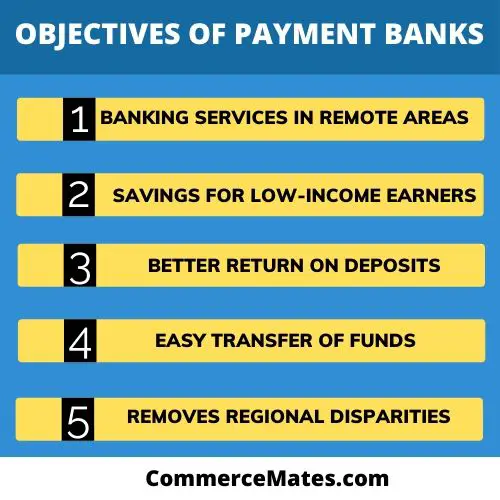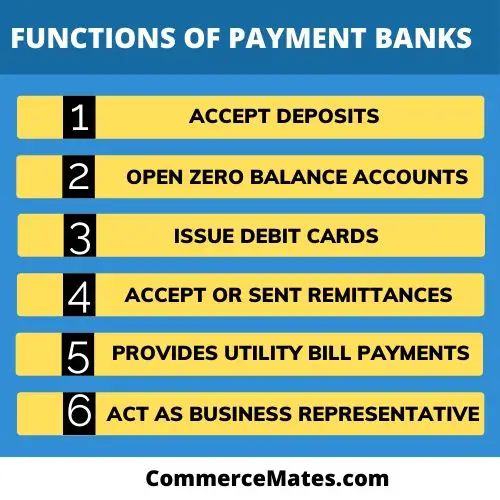Contents
Meaning of Payment Banks
Payments banks are a new type of bank introduced by the Reserve bank of India. These banks function as similar to other ordinary banks with some more restrictions. Payment banks are allowed to accept a deposit from customers only up to a maximum limit of Rs.1,00,000. They do not provide any credit facility, unlike other banks.
Payments banks aim at providing banking facilities to low-income earners, small businesses, and the unorganized sector. By introducing payments banks, RBI aims at expanding financial services in remote areas of the nation. These payments banks offer services like ATM cards, online banking, mobile banking, and fund transfers. At present, there are six payment banks operational in India.

Objectives of Payment Banks
- Banking Services in Remote Areas: Payment bank aims at providing banking services in rural and unorganized sectors. These banks serve the needs of migrant workers, small businesses, and low-income households in remote areas. Payment banks have connected more and more rural areas with the banking sector which traditional banks cannot do.
- Savings among Low-Income Earners: These banks encourage saving habits among low-income earners by accepting small amounts of deposits. Payment banks provide the facility to customers of opening accounts even with zero balance. People can deposit small amounts as per their convenience and are not required to maintain any minimum amount.
- Better Return on Deposits: Payment banks provide a higher amount of interest on deposits in comparison to other commercial banks. These banks pay up to 7.25% interest on people’s deposits which helps them in earning higher returns.
- Easy Transfer of Funds: The Introduction of payment banks has facilitated the easy movement of funds among people belonging to the undeveloped sector. These banks establish most of their branches in unbanked rural areas. It makes doing payments and transfers of funds quite easy for peoples.
- Removes Regional Disparities: Payment banks have led to reducing regional imbalances across the country. They are providing all banking services to people of rural areas where other commercial banks do not operate. People are availing better facilities with the minimum cost through these banks which removes regional disparities.

Functions of Payment Banks
- Accept Deposits: Payment banks accept deposits from customers like any other commercial bank. However, there is a fixed limit of Rs.1,00,000 set by RBI for accepting deposits by these banks.
- Open Zero Balance Accounts: They provide the facility of the opening bank account to low-income earners with zero balance. People are not required to maintain any minimum amount in their accounts with payment banks, unlike other banks.
- Issue Debit Cards: Payment banks issue both virtual as well as physical debit cards to their customers. These cards can be used for online payments or cash withdrawal from ATM machines.
- Accept or Sent Remittances: Payments bank provides facility to its customers of accepting and sending remittances from multiple banks. These banks use approved payment mechanisms such as NEFT, RTGS, and IMPS.
- Provides Utility Bill Payments: These banks perform the function of paying utility bills like water, electricity, and gas bills. Banks make all payments on their customer’s behalf automatically on time.
- Act as Business Representative of other Banks: Payment banks can work as a partner with other commercial banks through the approval of RBI. They can involve in selling insurance products, mutual funds, and pension products.